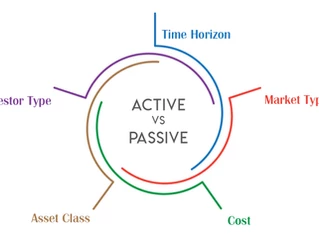This Article was originally published in The Global Analyst
“Active” is not dead and will never be
“If you've invested $1,000 with Buffett in 1965 would currently hold $4.3 million. However, if Berkshire had been a hedge fund charging 2 & 20, that $4.3 million would have accrued $300K to the investor with a stunning $4 million to the manager.-Terry Smith”
“By some counts, up to 86 percent of active funds underperform their benchmark, but by definition 100 percent of truly passive funds underperform theirs” Paul Smith
If there is one thing that has taken investment world by surprise during the last decade, it is the stupendous growth of passive investing. Passive investing refers to replicating the benchmark either in the form of an index fund or Exchange Traded Funds (ETF’s). The only difference between the two is while the former is a mutual fund where buying or selling should be done with the fund house, ETF’s (as the name imply) are traded in the exchange just like a stock and therefore more liquid. However, the key differentiating factor is while a passive fund just mimics a benchmark (after fees), an active fund attempts to generate excess returns (alpha) by straying away from the stated benchmark either by under weighting or over weighting stocks. In other words, active managers take stock bets in order to generate excess returns while passive managers just deliver market returns or benchmark returns (with no excess returns). In anticipation of alpha delivery, active managers charge hefty fees while passive manager’s fees are modest since they do not promise alpha.
According to Live mint, in the US, during FY 2003-16, total net assets of equity index funds increased by 3.5 times (from $0.39 trillion to $1.77 trillion), while that of active equity funds increased by just 0.7 times (from $2.73 trillion to $4.65 trillion). Slowly and surely passive funds are strangulating active funds and at this rate, it is easy to imagine an investment world with 100% passive managers with active management only finding a discussion in history books!
Not really! When hedge funds became prominent on the back of strong growth in assets, experts had similar view. However, the growth in hedge fund industry hit a steady state and later moderated. The debate of active vs. passive can be framed from five angles as below:

-
Market Type: The meritocratic rise of passive fund management is still a developed market phenomena and it is easy to explain why. Developed markets enjoy higher levels of market efficiency due to which extraction of alpha has become difficult over time. Adjusted for active fees, this means that clients /investors are better off focusing on asset allocation executed primarily through passive funds than investing with active managers. However, if one examines the data for emerging markets, the role of passive funds is still minuscule due to market inefficiency, which gives rise to plenty of alpha generating opportunities.
-
Asset class: Passive funds are popular among global equities and US equities, which are large and liquid markets. However, their popularity with emerging market equities is still suspect given the alpha opportunities explained above. In addition, the fixed income market is still not as ETF friendly as equities. Among alternative asset classes like private equity, real estate and hedge funds, passive investing is still at infancy stage given liquidity and cost constraints. Hence, the passive story is for now confined mostly to global, especially US, equities. Due to this, executing a comprehensive asset allocation strategy using only passive funds is proving difficult.
-
Investor Type: Adoption of passive funds is mostly prevalent among institutional investors compared to retail investors though it should be the other way around. If one looks at the data presented by Association of Mutual funds of India (AMFI), individual investors invest 8% of total ETF investment while institutions account for 92%. One reason could be that institutions have cost pressures and can be skillful to use passive funds in asset allocation while retail investors may not understand the impact of cost.
-
Cost: The rise of passive funds is clearly attributable to cost differential. For eg., in the US passive funds posted an expense ratio of 0.09% in 2016 while active equity funds were seven times more expensive with an expense ratio of 0.63%. In India, the expense ratio for active funds from FY 2008 to FY 2017 averaged 2.32% per annum and for ETFs it was 0.61% according to Live Mint. While retail investors with short-term outlook may miss the cost factor, long-term investors will certainly have to take this cost differential into account.
-
Time Horizon: Lastly, time horizon can truly change tilt the balance between active and passive. Let me explain this through an example of Reliance ETF (Junior Bees) primarily focused on Indian Large cap.

While the fund’s rank in the category was 70 out of 87 funds during the last one year, that rank improves dramatically to 4 when the time horizon expands to 3 years, and to 2 for 5 years and impressively to 1st rank when looked at from a 7 year perspective. In other words, if an investor’s time horizon is 5 years plus, he is clearly better off investing in passive funds than active funds. However, if one is looking at shorter periods, active managers can provide extensive alpha.
In summary, active managers are relevant to emerging markets where finding excess return is still possible. A recent study of 448 mutual funds by IIM Trichy professors (Nilesh Gupta and G Sethu) during the last 21 years found that gross returns by active funds exceed returns from Nifty total returns index by more than 11%, after accounting for costs on an annualized basis. That is huge alpha to think about. While passive funds will find increasing prominence in institutional asset allocation in developed markets, active managers will still have a field day in emerging markets.
Happy investing!